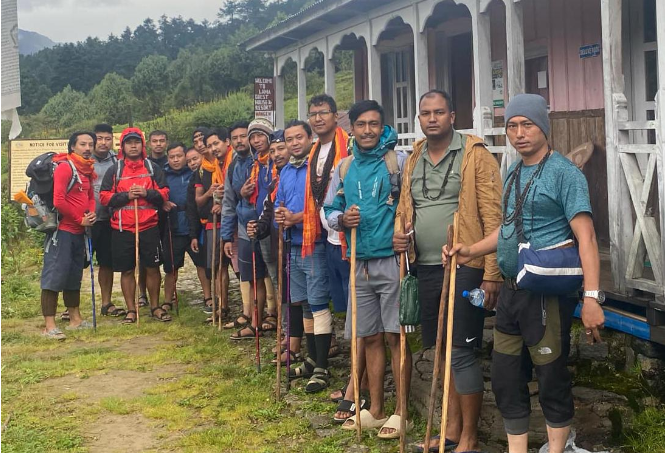On the auspicious occasion of Janai Purnima, celebrated on Bhadra 3, there has been a notable increase in the number of pilgrims traveling to Gosaikunda via the trekking route from Nuwakot. While around 2,000 pilgrims typically use this route in previous years, this year has already seen over 3,000 pilgrims heading towards Gosaikunda through Fedi in Dupcheshwar Rural Municipality-1 of Nuwakot by this morning.
According to Pemba Lama, Vice President of the Langtang Gosaikunda Helambu Hotel Entrepreneurs Committee, the popularity of the Nuwakot route, which was developed as an alternative to the traditional Dhunche route in Rasuwa, has grown significantly. He attributed this increase to the improved trekking paths and the desire of pilgrims to enjoy the natural beauty along the route.
“The upgrades to the trekking path, coupled with the scenic beauty it offers, have made the journey more appealing for pilgrims,” said Lama. “We have arranged accommodations, peace and security measures, and porter services for the pilgrims.” Lama also mentioned that there are well-equipped guesthouses and homestays along the route from Ghyangfedi in Nuwakot to Suryakunda, ensuring that pilgrims have access to necessary facilities.
Shankar Thapa, Chairperson of Dupcheshwar Rural Municipality, informed that security measures, food, lodging, guides, temporary hotels, drinking water, first aid, and toilet facilities have been arranged along the route, with support from the Nepal Police, Nepali Army, and volunteers. The municipality has also deployed volunteer teams at various points to assist and identify any potential issues faced by the pilgrims.
Pilgrims traveling to Gosaikunda can use the Nuwakot trekking route, with two primary starting points. The first option is to start a trek from Sundarijal in Kathmandu, passing through Chisapani, Kutungsang, Mangin Gauth, Thade, and Ghopte to reach Fedi. Alternatively, travelers can shorten the walking distance by using vehicles from Gangate in Bidur Municipality-5, Nuwakot, or from Tokha-Chahre in Kathmandu, and then continue through Kharnitar, Samundratar, Ramati, Ghyangfedi, Sisipu, and Kaseri to reach Fedi.
From Fedi, the pilgrims continue to High Camp and then to Suryakunda in Nuwakot before reaching Gosaikunda in Rasuwa. Chairperson Thapa noted that pilgrims taking this route also have the opportunity to visit the revered Dupcheshwar Temple, often referred to as the “second Pashupatinath,” and take a dip in Suryakunda, making this route a popular choice.
Pilgrims traveling from Kathmandu on foot and those using vehicles and then walking from Ghyangfedi in Nuwakot converge at Fedi. After reaching Fedi, they can proceed to High Camp and then to Suryakunda in Nuwakot before continuing their journey to Gosaikunda, which is the source of the Trishuli River. Suryakunda, located at a higher elevation than Gosaikunda, is also the source of the Suryamati (Tadi) River.
According to sustainable tourism project advocate Neelkanth Acharya, fewer pilgrims visit Suryakunda due to its higher altitude and the additional distance required to reach it. However, those traveling through the Nuwakot route to Gosaikunda have the unique opportunity to visit both Suryakunda and Gosaikunda on the same pilgrimage.
Acharya further mentioned that the trekking path has been upgraded, with stairs constructed in difficult sections, making the route more accessible. Along the way, well-organized guesthouses, homestays, and local committees, including those in the Langtang National Park buffer zone, are providing necessary support to the pilgrims.
Gosaikunda Area Development Committee Chairperson Sanjiv D.M. noted that there is always a large crowd of pilgrims at Gosaikunda during the Janai Purnima festival. “The fair, which started last Friday on Putrada Ekadashi, will continue until Monday. With the increase in pilgrims using various routes, we have ensured the availability of security, first aid, drinking water, and permanent toilet facilities,” he said.
The committee estimates that around 15,000 pilgrims will participate in the Gosaikunda fair this year, using both the Rasuwa and Nuwakot trekking routes. Gosaikunda, a sacred site at an altitude of 4,380 meters above sea level, holds religious significance for both Hindus and Buddhists.
“As per ancient mythology, during the churning of the ocean (Samudra Manthan) by gods and demons, Lord Shiva consumed the poison (Kalakuta) that emerged from it. To soothe the burning sensation caused by the poison, he struck the Himalayas with his trident, causing water to gush out and form Gosaikunda,” explained Chairperson D.M. “Gosaikunda is considered the source of the Trishuli River.”






